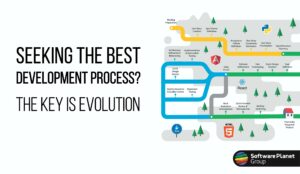Our customers often inquire as to how in the world our newer developers will be skilful enough to deal with our development process — and really, who can blame then?
After all, how laid-back and comfortable would you feel if the man assigned to the critical case of your tooth extraction were an obvious hatchling fresh out of dental school?
“Let’s see then… I think this, no, erm… this over here is what I need! Right, could you open up your mouth, please? Uh huh… Oh dear. Oh no. That won’t work, will it? Well, maybe something sharper!”
Horrifying, right? Of course, to begin with, the words “comfortable” and “dentist” are hardly representative of a pairing made in heaven; but the point, nonetheless, is you would probably feel a lot more at ease if the drill were handed over to an experienced professional.
Now thankfully, as you probably know, our own situation is entirely different. But just to help to allay those fears, Software Planet would now like to reveal our careful and deliberate process for successfully integrating newer arrivals into the heart of our company.

Phase 1: Post-academic education
Our first step towards integrating newer talent is seen in our internship programme. Essentially, this acts as a springboard for young prospects to begin their careers and may in many ways be understood as a university supplementation programme, or a school of reality checks.
This is largely due to the fact that nowadays, many institutes of higher education are failing to adequately prepare their students for the real, post-academic world.
As a result, we teach graduates exactly what it takes to become fantastic programmers, educate them on the level of expertise that they must strive to achieve, coach their way through our standard Agile development process and crucially, make sure they are well aware of all our expectations.
Critical as well is that this internship is primarily a hands-on event. Interns will actively participate in archetypal projects and be equipped with all the necessary information pertaining to procedure and technology.
Phase 2: Sandbox
In our second phase, because we do not yet feel comfortable assigning new recruits to any mainline projects, successful interns are then moved on to take part in our own internal works.
These are manifold and may follow a variety of models, from social to financial. In effect, therefore, the stage functions very much as our own internal sandbox. Every project our prospects work on is very much alive and real, yet because it is our own, failing here is perfectly acceptable, as it will not carry over any lasting or detrimental effects — especially not to our customers!
Phase 3: Secondary roles
Our third and final stage sees recruits at long last attaining their very first taste of a real commercial project. Even so, however, this too is done with a perceptible measure of caution.
More specifically, although these projects are indeed done for our customers, programmers at this level are to never be entrusted with primary roles in development. Instead, they are expected to work under the direct supervision and management of experienced team leaders.
This, in essence, is the final veil of separation between recent arrivals and established developers. At this point in time, our integration plan becomes all about interacting with real customers, learning how to make wise and appropriate decisions, and of course, gaining practical knowledge that will help trainees moving forward.
Additional measures
Despite this extensive process, further measures are also in place to guarantee a successful integration.
Whenever we hire developers, for instance, we strongly emphasise the importance of possessing full-stack experience. This means ensuring that recruits are open enough to not remain focused on a single technology, but instead are able to zero in on the end-to-end implementation of features.
In practice, of course, this also allows us to fulfil one of SPG’s main priorities — to use not the technologies that we prefer, but rather the right ones, relative to each project.
In this way, all our developers are extremely versatile, being competent enough to single-handedly handle entire pieces of functionality, including frontend, backend and databases.
And finally, we also try to instil in our recruits a powerful mindset of product development. This in fact is a huge divider between SPG and other more traditional software companies. Where others are primarily concerned with their work hours and deadlines, we are wholly devoted to addressing real problems.
So relax!
As you can see, while the fear of a new dentist may indeed be perfectly rational, placing your faith in our younger developers should hardly be put in the same box.
Thanks to our comprehensive training programme and thoughtful fail-safe mechanisms, not only are we able to bring in new arrivals properly and up to speed, but also guarantee the same level of service that you have grown to expect from SPG — for many years to come.


